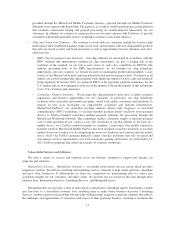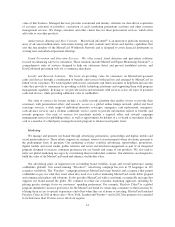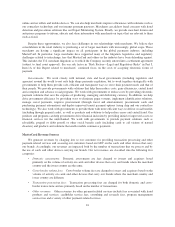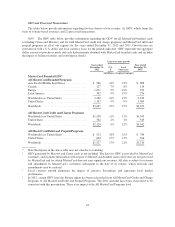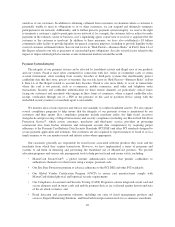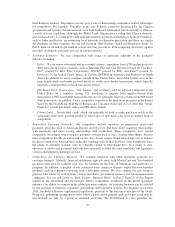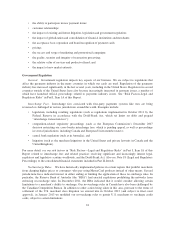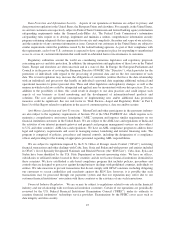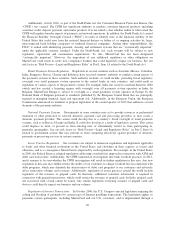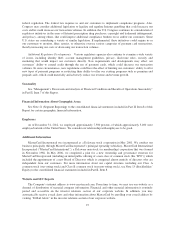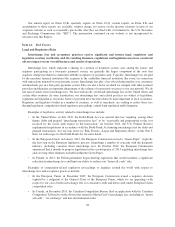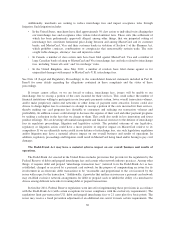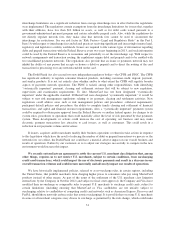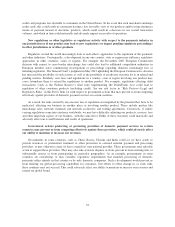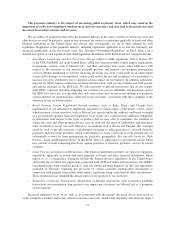MasterCard 2012 Annual Report Download - page 27
Download and view the complete annual report
Please find page 27 of the 2012 MasterCard annual report below. You can navigate through the pages in the report by either clicking on the pages listed below, or by using the keyword search tool below to find specific information within the annual report.restrictions on a merchant’s ability to route a transaction over any one of the networks that is enabled on
a debit card or prepaid card. These events have resulted in challenges, as well as potential opportunities
to compete for business in this area.
•Transaction Processors. We face competition from transaction processors throughout the world, such
as First Data Corporation and Total System Services, Inc., some of which are seeking to enhance their
networks that link issuers directly with point-of-sale devices for payment transaction authorization and
processing services. Certain of these transaction processors could potentially displace us as the provider
of these payment processing services.
•New Entrants and Alternative Payments Systems. We also compete against relatively new entrants and
alternative payment providers, such as PayPal®(a business segment of eBay), which have developed
payments systems in e-commerce, across mobile devices and in physical store locations. Internet
payments is an increasingly competitive area, with PayPal as an established and important player and a
proliferation of new online competitors. Among other services, these competitors provide internet
payment services that can be used to buy and sell goods online, and services that support payments to
and from deposit accounts or proprietary accounts for internet, mobile commerce and other applications.
A number of these new entrants rely principally on the internet and potential wireless communication
networks to support their services, and may enjoy lower costs than we do. Additionally, PayPal has been
expanding to a presence in physical locations. Specifically, PayPal’s partnership with Discover
Financial Services will provide PayPal with access to Discover’s network and several million merchant
locations in the United States, with the potential to expand globally in the future. The electronic
payments industry is also facing changes in services and technology related to mobile payments and
emerging competition from mobile operators and handset manufacturers. Micro-payments on social
networks such as Facebook®are relatively small today, but have the potential to grow rapidly,
representing the potential for competition from a new payment form.
Financial Institution Customers.
•Pricing. We face increasingly intense competitive pressure on the prices we charge our customers. We
seek to enter into business agreements with customers through which we offer incentives and other
support to issue and promote our cards. In order to stay competitive, we may have to increase the
amount of rebates and incentives we provide to our customers and merchants, as we have in the last
several years. See our risk factor in “Risk Factors—Business Risks” in Part I, Item 1A related to the
increasingly intense competitive pressure we face on the prices we charge our customers.
•Banking Industry Consolidation. The banking industry has undergone substantial accelerated
consolidation over the last several years, and we expect some consolidation to continue in the future.
Consolidations have included customers with a substantial MasterCard portfolio being acquired by
institutions with a strong relationship with a competitor. Significant ongoing consolidation in the
banking industry may result in a substantial loss of business for us. The continued consolidation in the
banking industry, whether as a result of an acquisition of a substantial MasterCard portfolio by an
institution with a strong relationship with a competitor or the combination of two institutions with which
we have a strong relationship, would also produce a smaller number of large customers, which generally
have a greater ability to negotiate pricing discounts with us. Consolidations could prompt our customers
to renegotiate our business agreements to obtain more favorable terms. This pressure on the prices we
charge our customers could materially and adversely affect our revenue and profitability. See our risk
factor in “Risk Factors—Business Risks” in Part I, Item 1A of this Report related to additional
consolidation or other changes in or affecting the banking industry.
Competitive Position. We believe that the principal factors influencing our competitive position in the
global payments industry are:
• the ability to develop and implement competitive new electronic payment programs, systems and
technologies in both physical and digital environments;
23


